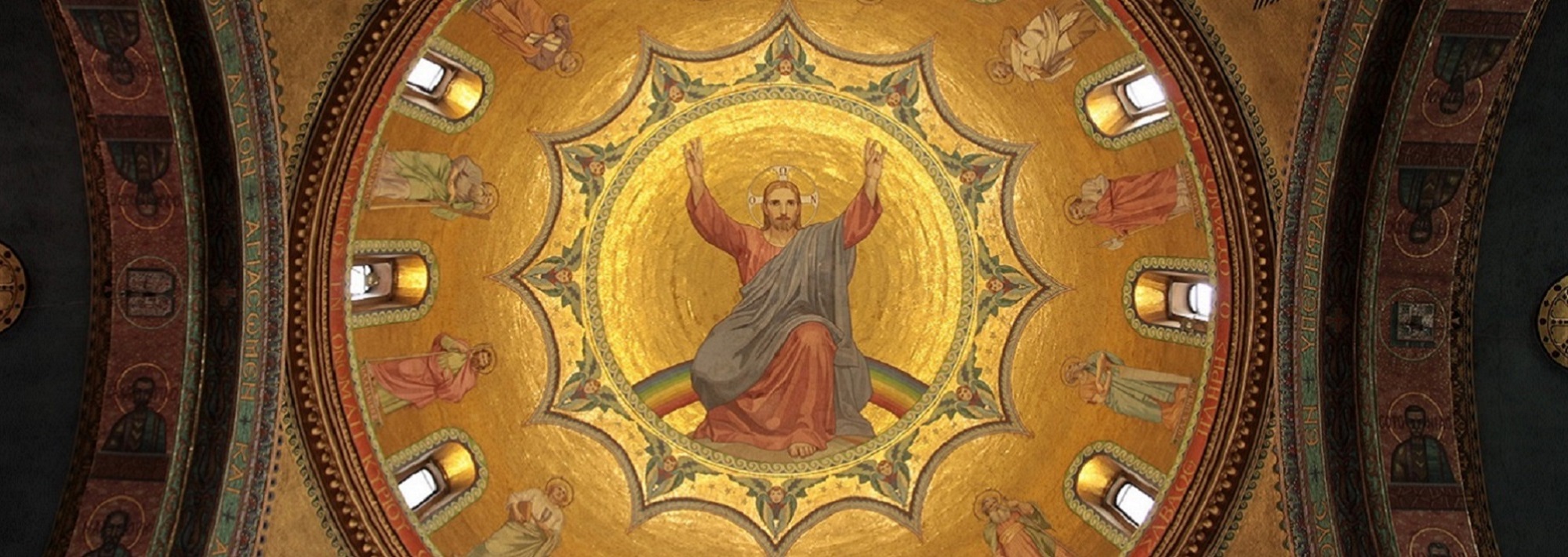Click on each section to discover more about the Cathedral’s history:
1670 – 1682
The First Orthodox Church in London – The Assumption of the All-Holy Mother of God
Η Πρώτη Ορθόδοξη Εκκλησία του Λονδίνου: Η Κοίμηση της Θεοτόκου
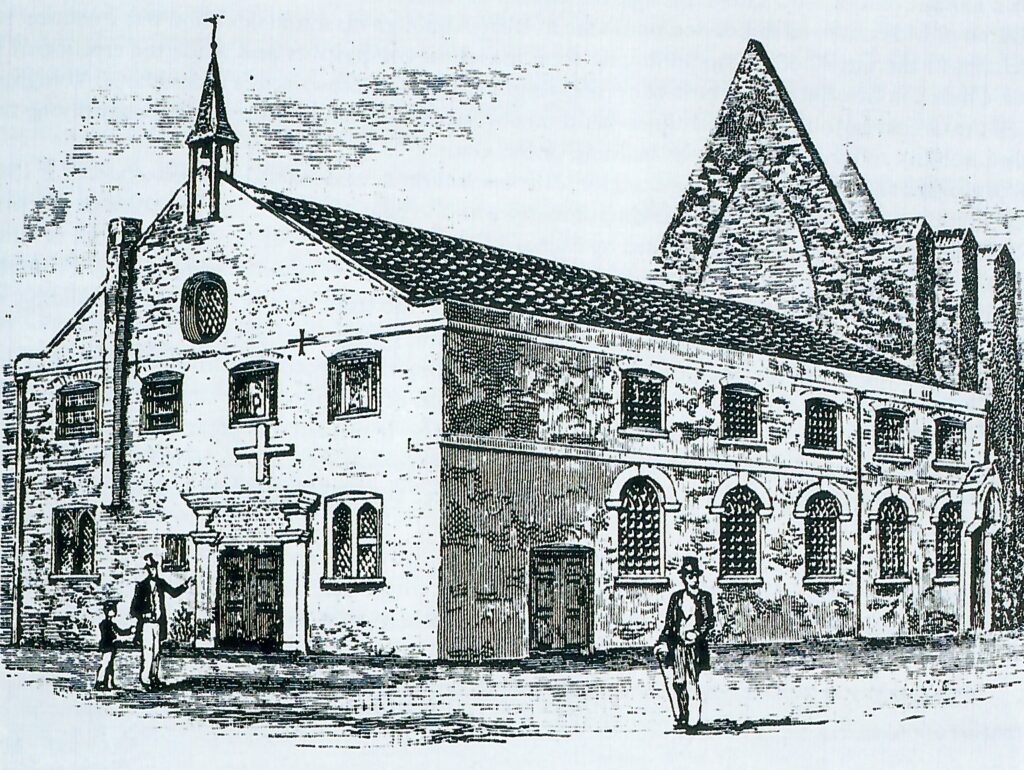
The origins of the first Greek Orthodox Church in London dates back to the late 17th century and was founded as a result of the growing expansion and the establishment of the Greek community in the City of London. In 1674, a number of the London Greek community led by a priest Fr. Daniel Voulgaris petitioned the Privy Council, King Charles II advisors, for permission “to build a church in any part of the city of London, where they may freely exercise their religion according to the Greek Church”.
Permission was granted in 1675 and building work began in 1677, with the completion of a small church in 1681, dedicated to the Assumption of the All-Holy Mother of God. The main driving force in its establishment and raising funds being the Metropolitan of Samos, Joseph Georgerinis from the island of Milos.
The church was located at the then edge of the city in Soho in Hog Lane, off Charing Cross Road, which eventually became and is now known as Greek Street. However, at the time the majority of London’s Greek community lived and worked in the City and around the ports of London. The church’s location was too far away from where Greeks were generally concentrated; so the Orthodox congregation were unable to attend Liturgy regularly or support its function. The church ended up being sold in 1682 and was taken over by French Protestant Huguenots who had fled to England as refugees.
The building itself was demolished in 1934, but the inscription which commemorated the foundation of the first Greek Orthodox Church has survived and can be seen in the left part of the Cathedral’s narthex (the entrance of the church).

The Inscription reads in English: This Church was erected in the year of our Lord 1677 for the use of Greeks in the reign of the Most Serene Charles II, in the hegemony of the most noble Prince James, when Bishop was the Right Reverend Henry Compton, at the expense of the above and of other bishops and noblemen, and by the labours and humility of Joseph Georgerinos of the island of Milos, Metropolitan of Samos.
1712 – 1837
The Imperial Russian Embassy Chapel and The Greek Chapel of Christ the Saviour
Tο Παρεκκλήσι της Ρωσικής Πρεσβείας και το Ελληνορθόδοξο Παρεκκλήσιο του Σωτήρος
In 1712 the Patriarch of Alexandria Samuel Kapasoulis, sent the Metropolitan of Thebes, Arsenius to England on a mission to ask for financial aid for the patriarchate from Queen Anne, which she gave.
During his time in London, Metropolitan Arsenius came into contact with Non-Jurors; a group of Anglican clergy who refused to swear allegiance to the newly restored English monarchy, yet continued to serve congregations independently as priests and bishops.
Metropolitan Arsenius’s aim was to negotiate with the Anglican Non-Jurors for a union with the Orthodox Church. He considered that the establishment of a Greek Church in England would assist him in this mission, therefore he converted a private house into a Greek chapel, where he celebrated the Orthodox Liturgy every Sunday.
The dissolution of the first Orthodox Church and Metropolitan Arsenius’s temporary chapel meant that the spiritual needs of the London Greek Orthodox community could not be met. So they ended up worshipping at the Russian Orthodox Chapel, originally established off the Strand. Then moving to sites in Burlington Arcade, Great Portland Street and finally to the Imperial Russian Embassy at 32 Welbeck Street in London’s West End. In the first half of the 18th century, the Russian Orthodox Chapel was served by Cypriot Archimandrites Fr. Gennadios and his nephew Fr. Bartholomeos Kassanos. It also acted as a registrar for birth, deaths and marriages for the London Greek community.
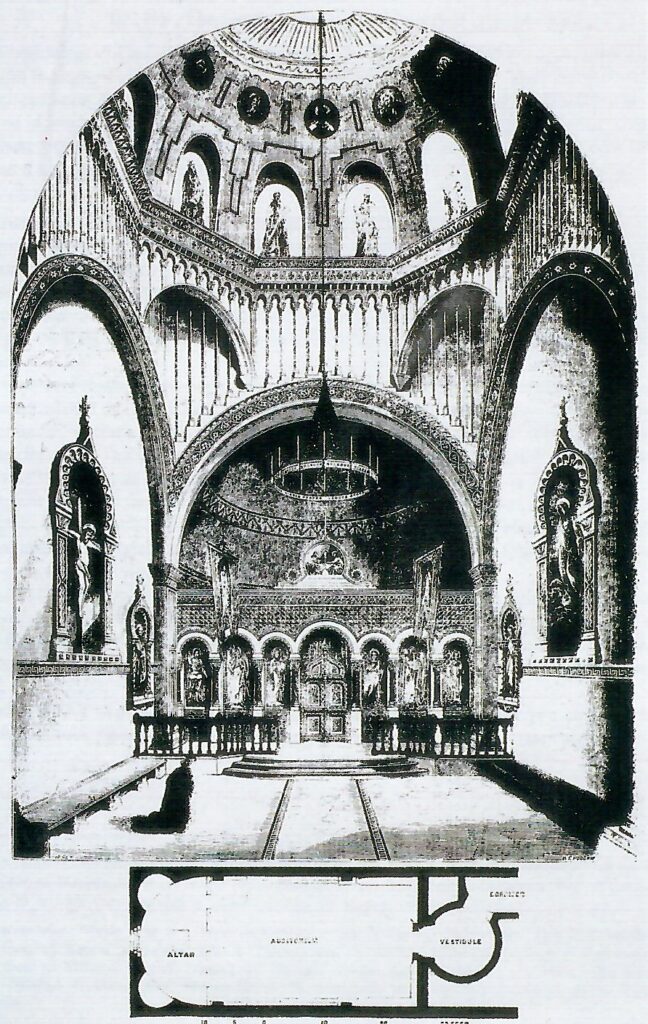
Chapel of the Russian Embassy
By the mid-19th century the London Greek community had been transformed from an insignificant and mainly transient minority into an influential and wealthy group of commercial leaders. The first step in re-establishing a Greek Orthodox place of worship was through a Greek priest in London called Fr. Galaktion Galatis. Under the auspices of the Greek merchant community he rented a hall in the district of Finsbury Circus in the City of London for Orthodox worship.
This prompted the community elders of the time, many of whom had places of business in Finsbury Circus, to set up a Greek Orthodox Chapel in 1837, dedicated to Christ the Saviour, in gratitude for the liberation of Greece in the War of Independence. The chapel was situated on the first floor of the shipping firms of Rallis Brothers and Ionides Company. Archimandrite Fr. Dionysios Xenakis was brought from Chios to officiate.
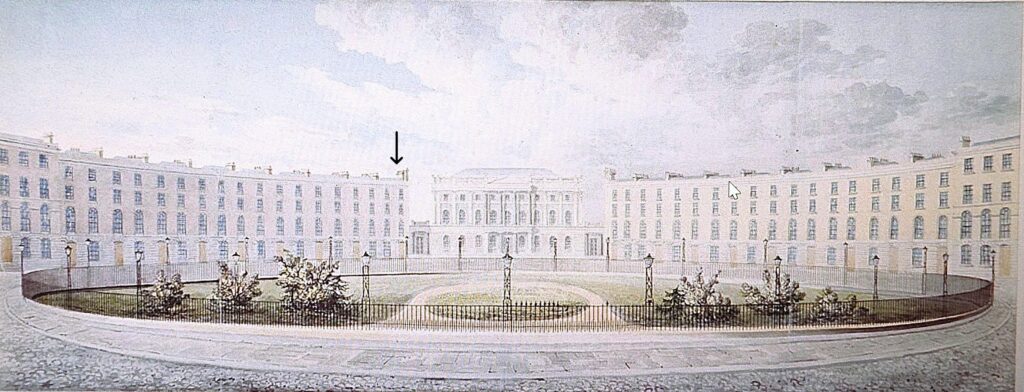
The Greek Chapel (indicated) at the offices of Rallis Brothers and Ionides Company, 9 Finsbury Circus, London
1843 -1879
The Greek Orthodox Church of Christ the Saviour
Η Ελληνορθόδοξη Εκκλησιά του Σωτήρος
As early as 1843, the House of Prayer at 9, Finsbury Circus was already becoming too small for the growing needs of the London Greek Orthodox community. A committee was formed consisting of leading London Greek merchants and businessmen of the time under Pandias S. Rallis. In July 1846, this committee, which became known as the Brotherhood, agreed that the time had come to build a dedicated Greek Orthodox Church in London, funded by voluntary contributions from the Greek community.
A suitable site was found, conveniently within the City of London in Winchester Street, 82 London Wall. Renowned Greek architect Lysandros Kaftanzoglou was commissioned to design the church, dedicated once again to Christ the Saviour. Kaftanzoglou was also the Chancellor of the National Technical University of Athens, known as the Polytechnic, a building he designed amongst others in the neo-classic style in post-Independence Athens.
The church celebrated its first liturgy Christmas 1849; and it attracted a great deal of attention because it was designed in the Byzantine style, which was almost unknown in London at the time.
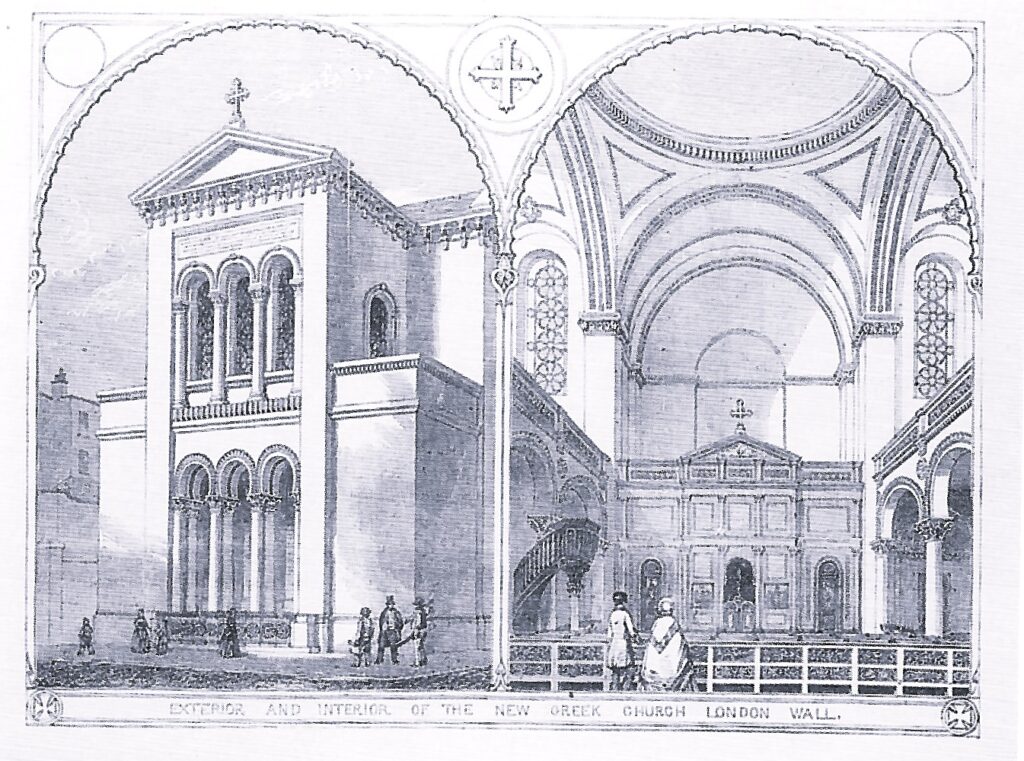
1872 – 1882
The Greek Orthodox Church of the Divine Wisdom of God
Η Ελληνική Ορθόδοξη Εκκλησία της Του Θεού Αγίας Σοφίας
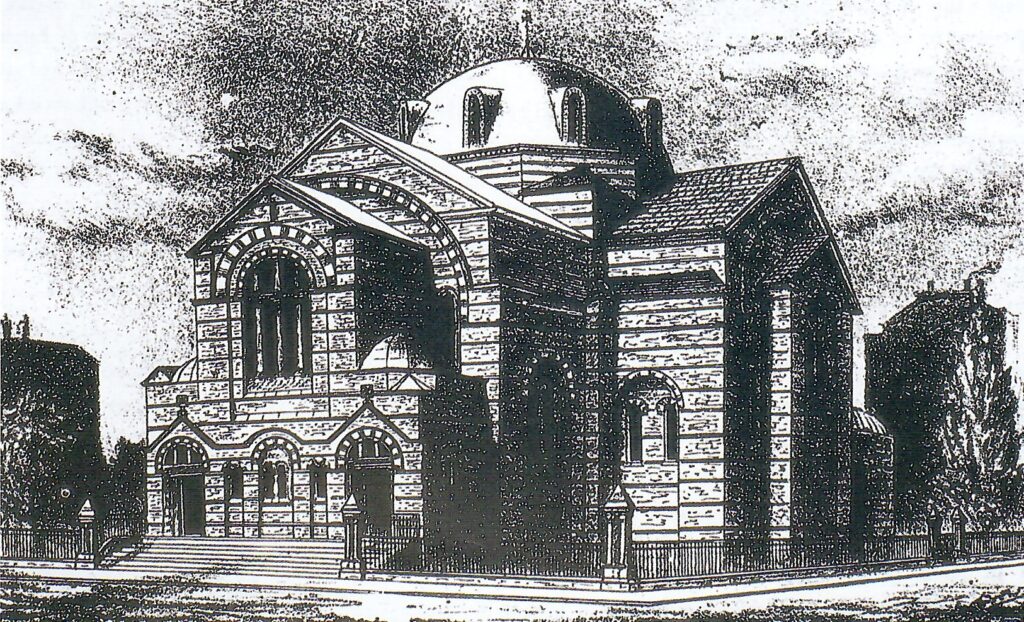
By 1870 the needs of the London Greek community had changed once again, their numbers had increased from several hundred to the thousands. The merchant families had begun to move their private residences away from the City to the West End and to areas around Hyde Park, Bayswater and Holland Park. This gave the Brotherhood of the Church the impetus to build a new larger place of worship for the Orthodox faithful.
At the Community’s General Assembly in January 1874, an agreement was reached on the site, financing and building of the New Greek Church in Bayswater. A Building Committee was formed under the Chairman Emmanuel Mavrocordatos, together with Constantine Ionidis, Sophocles Constantinidis, Petros Rodocanachi, Paraskevas Sechiaris and Dimitrios Schilizzi. A Finance Committee was also set up under Antonios Rallis to oversee expenditure and collect the voluntary contributions made by members of the London Greek community.
The Committee was also assisted in its task by lawyer and renowned Byzantinist Edward Freshfield and it appointed architect John Oldrid Scott to design a church in the Byzantine style, which was to be dedicated to the Divine Wisdom of God St. Sophia John Oldrid Scott, was the second son of famous Victorian architect Sir George Gilbert Scott, who designed St. Pancras Railway Station and the Albert Memorial in Kensington. John Oldrid Scott specialised in Gothic ecclesiastical architecture but his designs for the New Greek Church in Bayswater also evoked the magnificence of the Cathedral of Haghia Sophia in Constantinople.
In order that expenditure should not exceed the estimate, the Committee proceeded to make an exact preliminary study of every aspect of the building works. The quantities, measurements, materials and complete design were set out in such detail that 600 architectural plans and construction drawings had already been prepared, before commencement of the building contract, which the Committee assigned to Messrs. Kirk and Randall of Woolwich in May 1877.
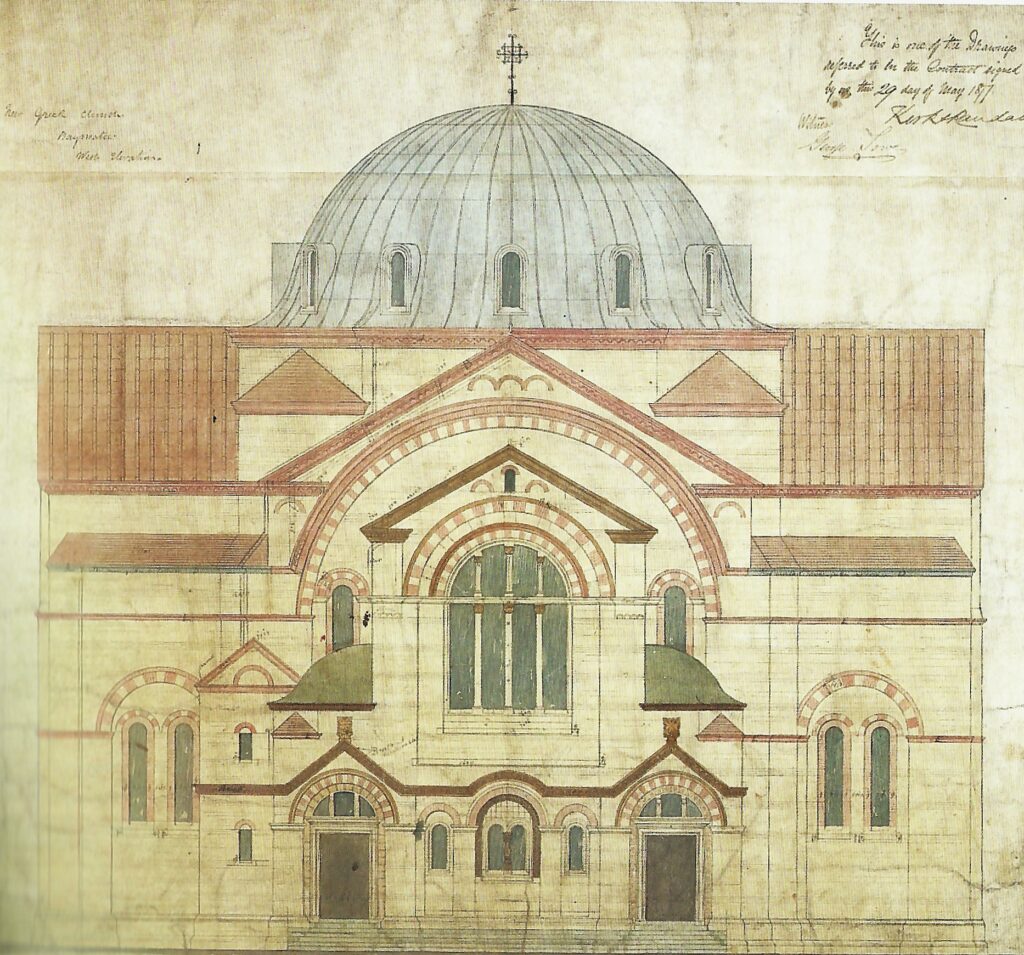
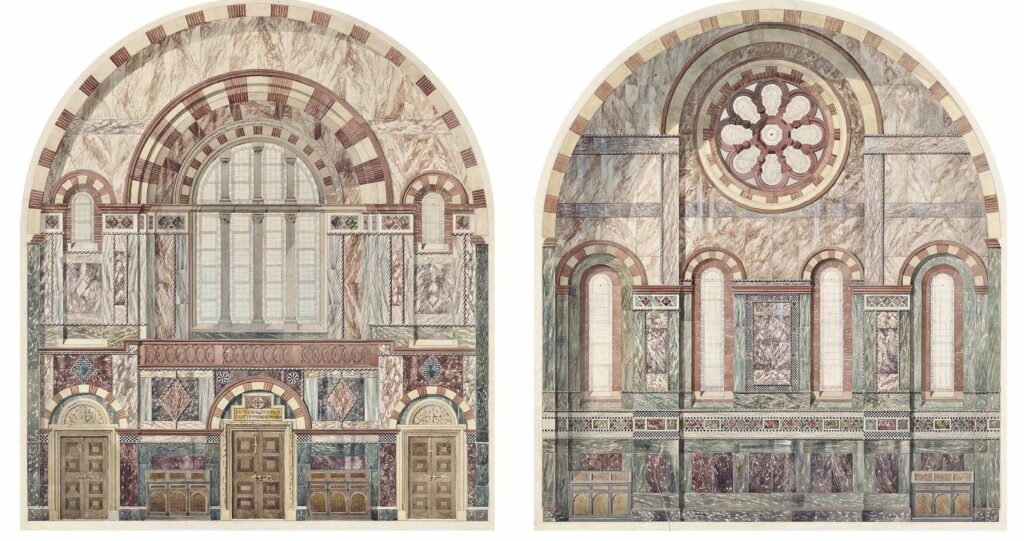
Contract drawing showing the entrance and other aspects of the church, signed by John Oldrid Scott (RIBA Drawings Collection)
In June 1877 the foundations of the Church were marked out, and a month later on July 18 of the same year, the foundation-stone was laid in a ceremony by Eustratios Rallis, the respected elder of the London Greek community. The silver trowel used for the laying of the Church’s foundation is now kept in the sacristy.
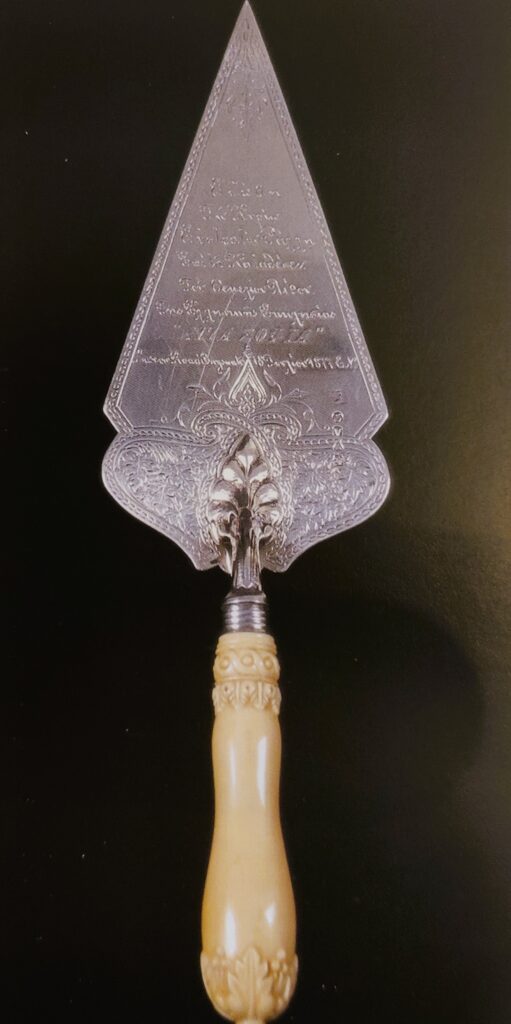
On 1st June 1879, the first liturgy was held at the new Church of the Divine Wisdom, with Archimandrite Fr. Hieronymos Myriantheus celebrating the Feast of Pentecost. On completion of the majority of the interior, the Church was consecrated on 5th February 1882, by Archbishop Antonios Hariatis of Corfu.
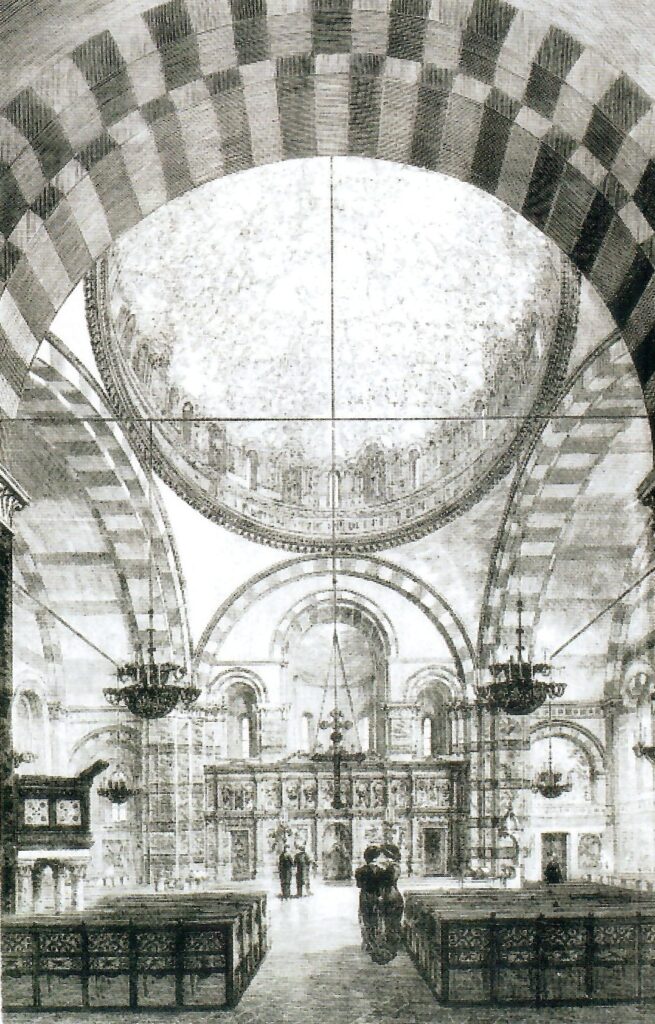
The interior of the New Church of St. Sophia, from the Builder Magazine, 1882
From the 19th Century to the Present Day
Από τον 19ο αιώνα έως σήμερα
There is much to note in the history of the interior of the Cathedral of the Divine Wisdom.
The church’s woodwork and marble were carved by William Farmer and William Brindley. They used large quantities of dark green marble from Tinos, darker bands of Portoro marble for the cladding and light Fosterley marble for the plinths. The iconostasis was designed by John Oldrid Scott himself, measures approximately 25 feet (7.6 meters) high and is made from Canadian walnut, inlaid with other woods of various colours and mother-of-pearl.
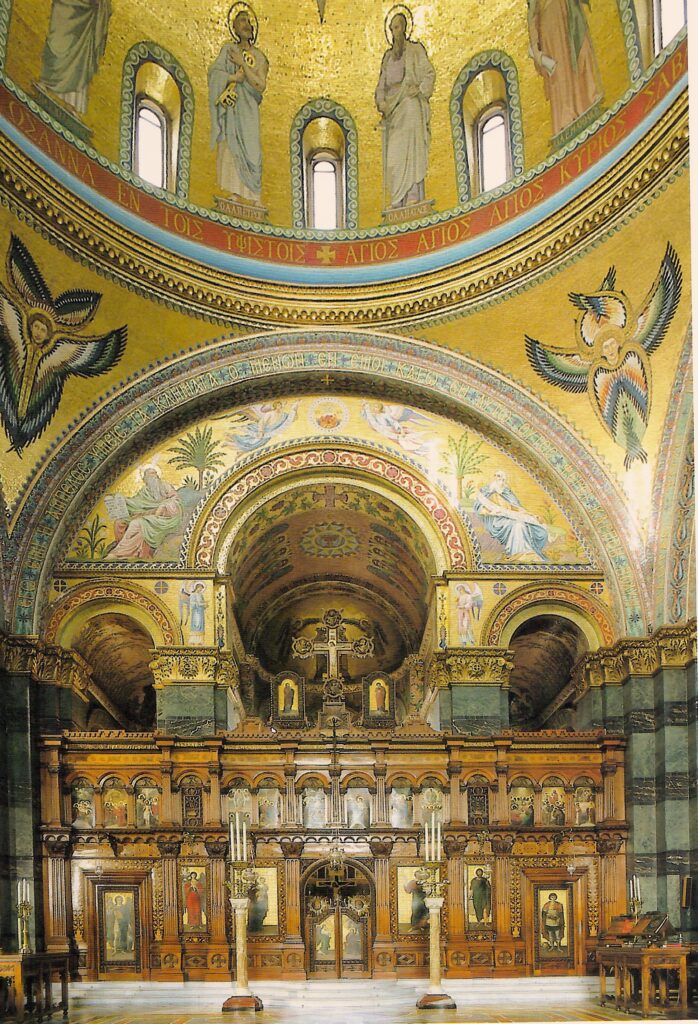
The inset panels of the iconostasis were all painted by Bavarian artist Ludwig Thiersch who had been a professor at the Athens School of Fine Arts. He also painted the large oil painting in the ‘South’ transept, on the right wall adjacent to the iconostasis, titled “Suffer the little children to come unto me” in 1881. His naturalistic style had already been introduced into Orthodox churches in Vienna, St. Petersburg, Karlsruhe and St. Nikodemos in Athens.
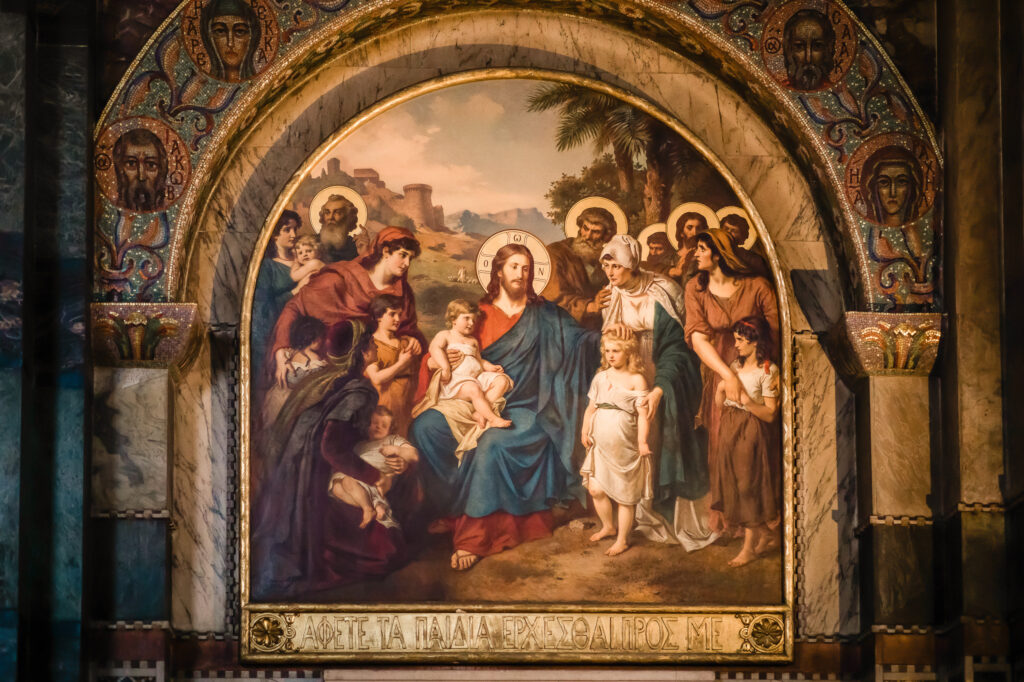
The floor mosaic of the two-headed eagle, the symbol of Byzantium was laid in 1889 after the Church’s consecration.
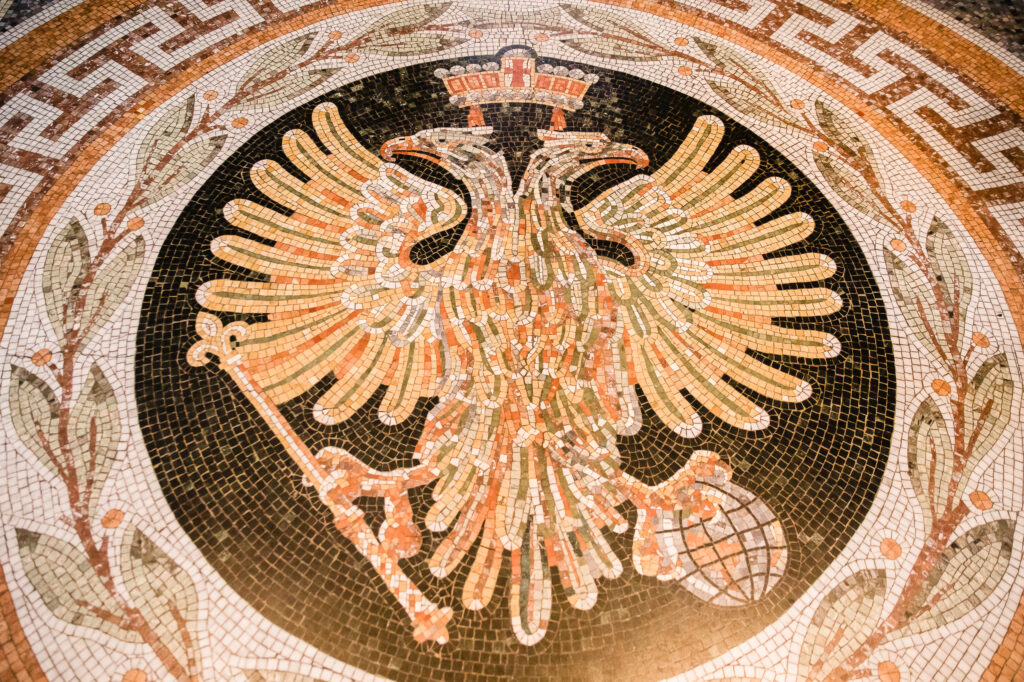
The mosaic work in the dome of the church depicting Christ the Pantocrator, His Apostles, the Seraphim and Cherubim, and the figures of Moses and Aaron decorating the Sanctuary began in 1891 and were completed in 1893. The work was carried out by mosaicist G.M Mecenero following the design of British artist Arthur George Walker. He became well-known for his war memorials and public sculptures, the most famous being of Florence Nightingale in London’s Waterloo Place.
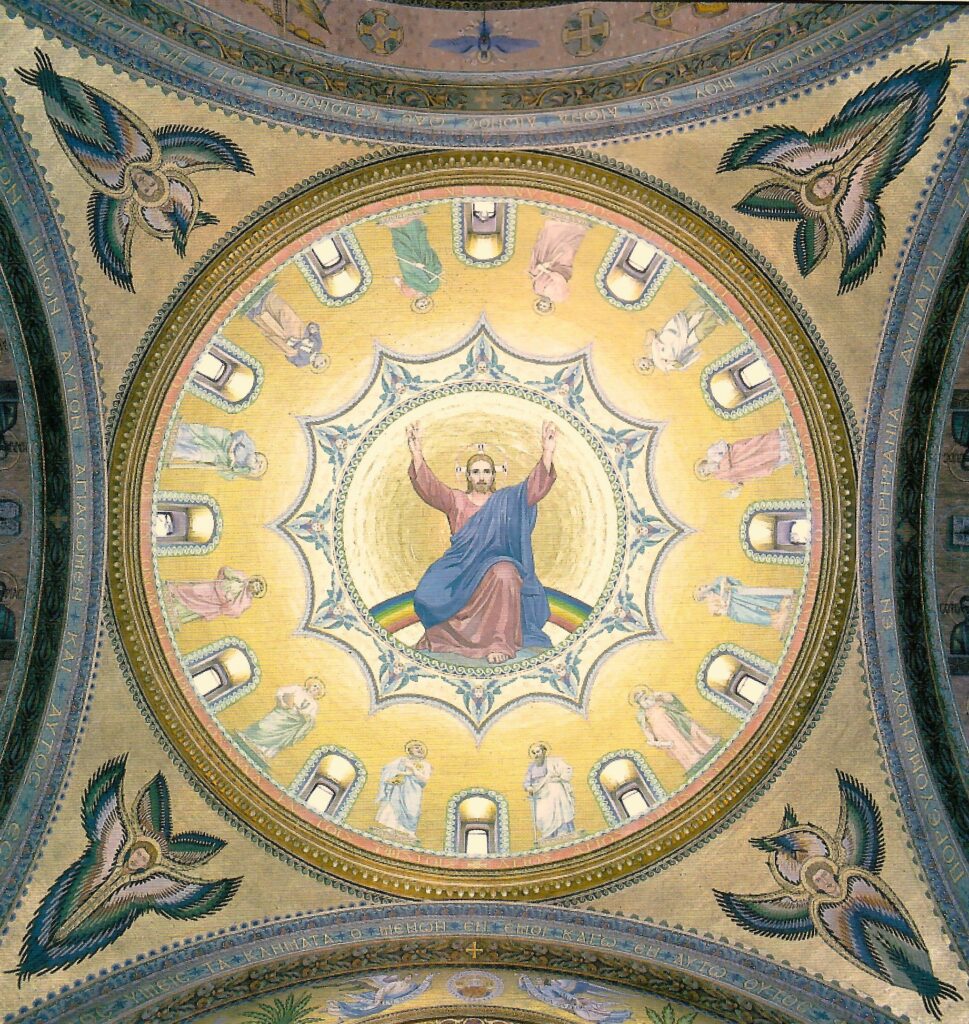
Further mosaics were added in the Church’s Sanctuary and arches by Russian mosaicist Boris Anrep in 1926, he also decorated further sections of the Cathedral between 1932 and 1956. Originally a law professor in St. Petersburg, Anrep developed an interest in Byzantine art and mosaics which also led to commissions in the Tate Gallery, the National Gallery and the Bank of England.
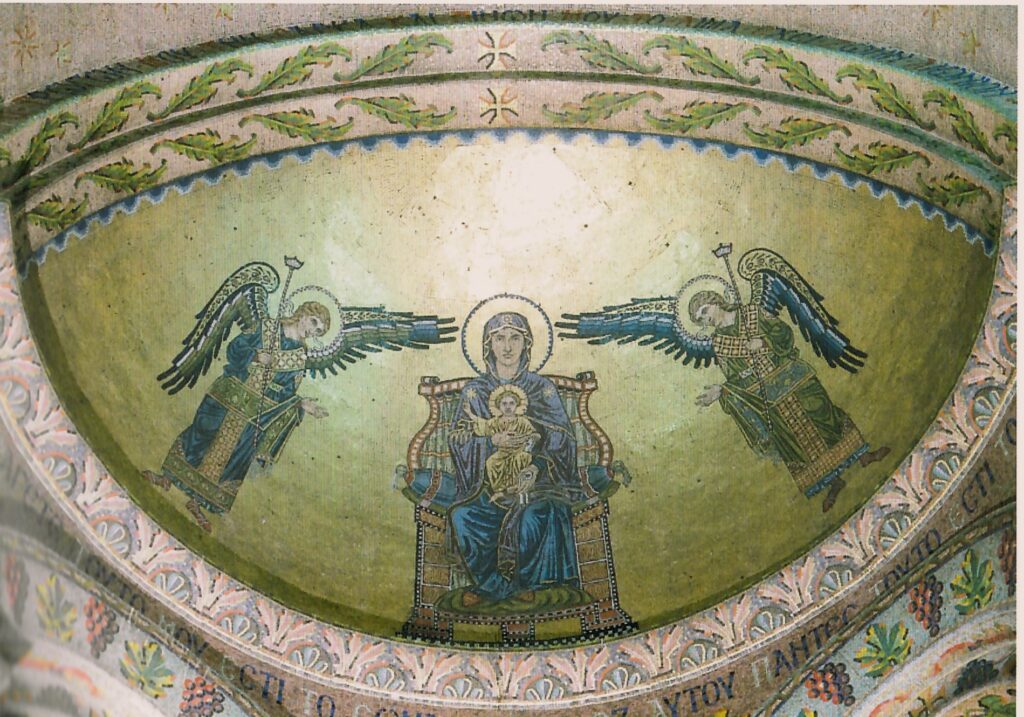
In the mid-to-late 1990s a series of mosaics of saints were added to the entrance of the Cathedral by Greek mosaic artists Sotiris Varvoglis and Fanis Mavridis.
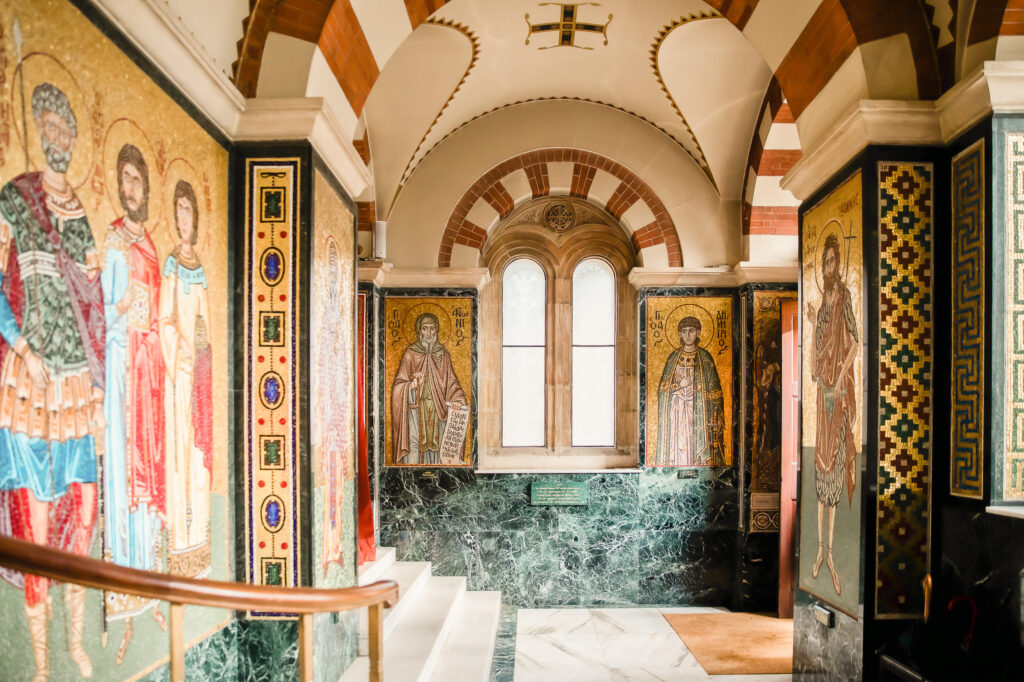
The impressive three-dimensional silver cross with ruby lamps hanging from the aisle, was donated to the church by the mother of Emmanuel Mavrocordato in 1896. Some of the 279 carved oak pews pre-date the building, since they were transferred from the original church of Christ the Saviour in London Wall.
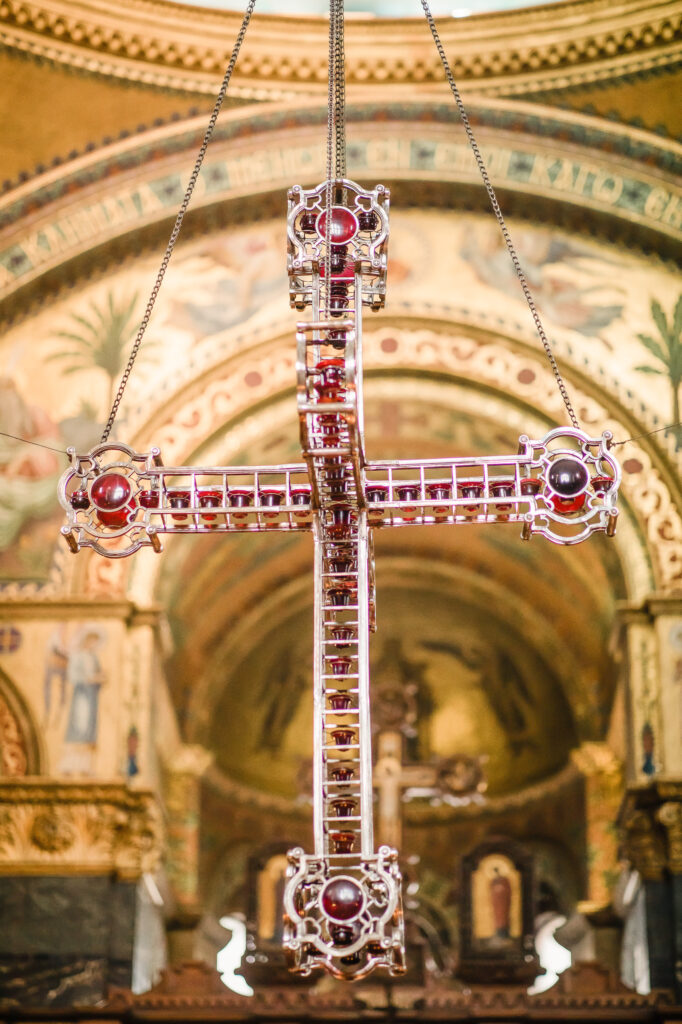
In 1922, the Church of the Divine Wisdom of God St. Sophia was designated a Cathedral by the Ecumenical Patriarchate of Constantinople, part of the newly-created Diocese of Thyateira, named after the ancient See of Thyateira in Asia Minor, with jurisdiction over Central and Western Europe.
During World War II, London was the seat of the Greek government in exile and St Sophia became the ‘Cathedral of the Greek Nation’.
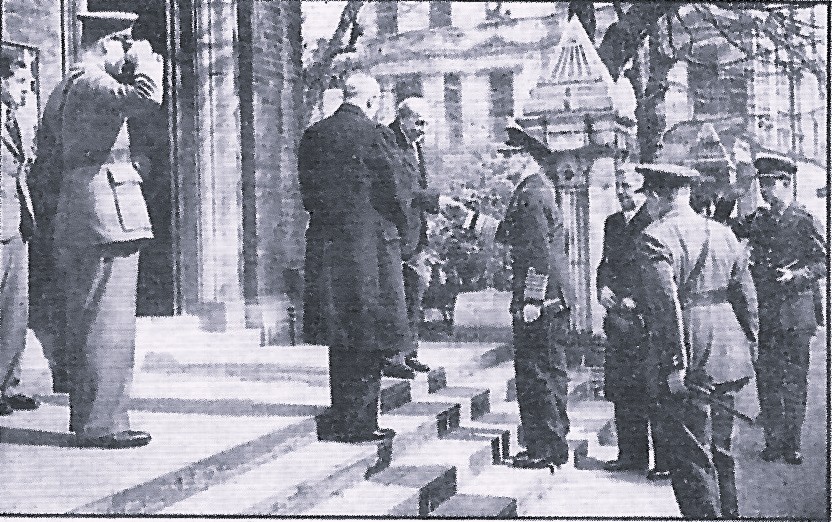
King George II of Greece attending a Doxology (Te Deum) to mark Independence Day, March 25th, 1944.
The church’s Crypt was requisitioned as an air-raid shelter and the building also suffered bomb damage and shrapnel from anti-aircraft shells which pierced the dome. The subsequent repairs were not completed till 1953.
The Cathedral was first listed as an English Heritage site in 1987 and achieved Grade I listed status in 2010.
In 2006 the area under the Sanctuary was converted into a small museum, under the auspices of Bishop Theodoritos of Nazianzou, with a donation from the A. G. Leventis Foundation. The Treasury Museum exhibits vestments, books and silverware from the Cathedral’s collection and is opened by appointment.
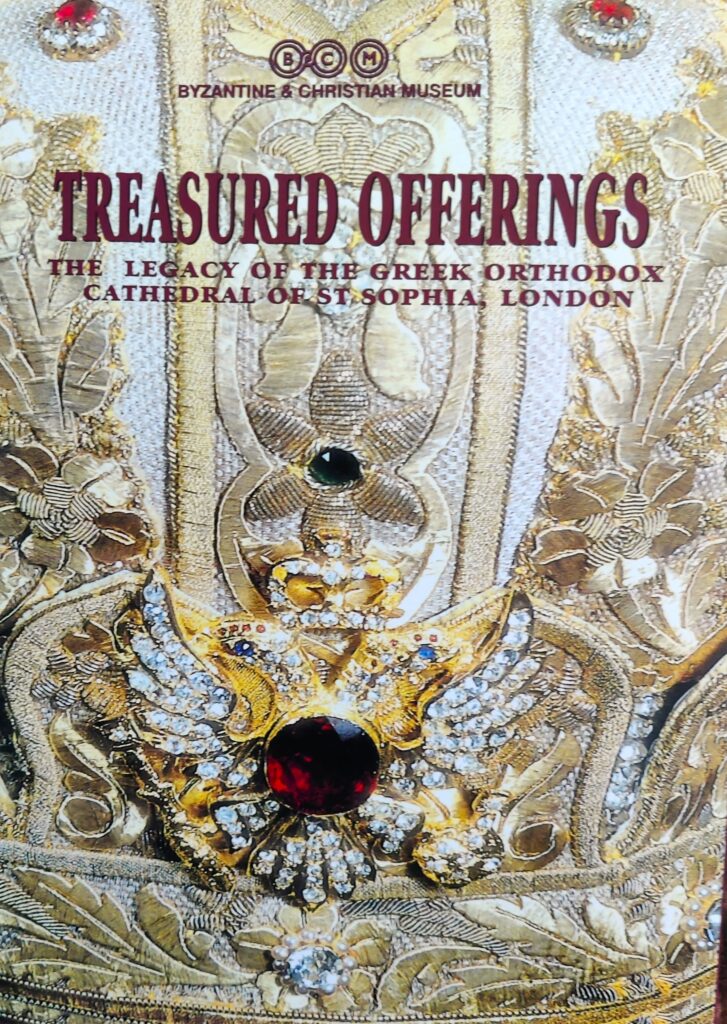
The Cathedral’s Archimandrites and Clergy
Αρχιμανδρίτες και Κληρικοί του Καθεδρικού Ναού
1879 – 1886: Hieronymos Myriantheus (1838-1898)
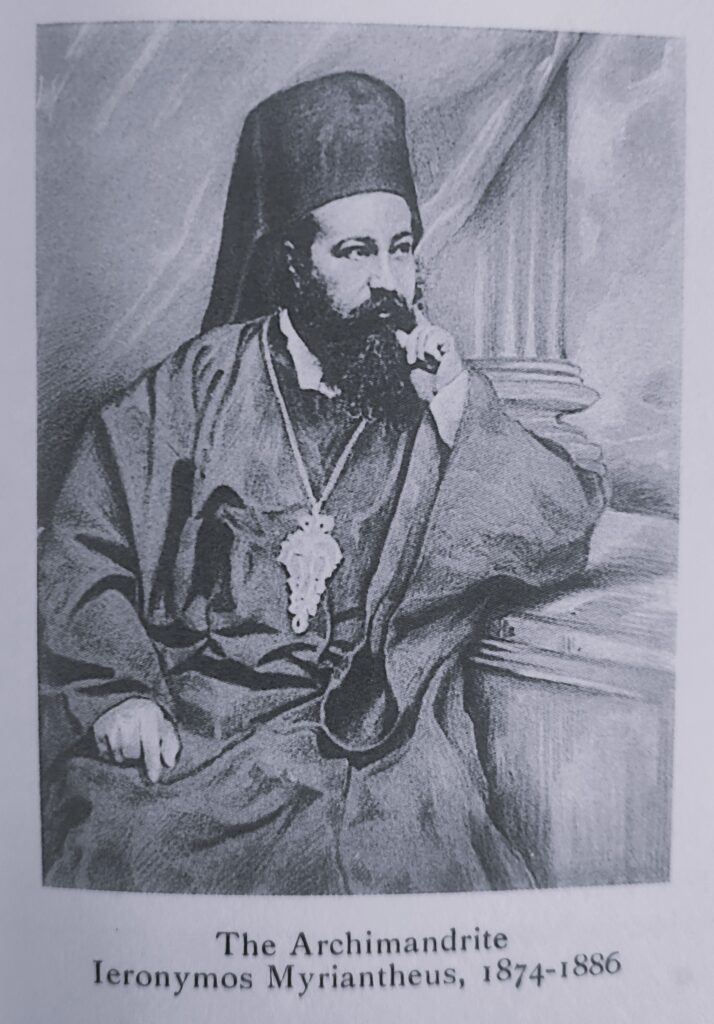
1886 – 1894: Dionysios Plessas, Metropolitan of Zante (1852-1934)
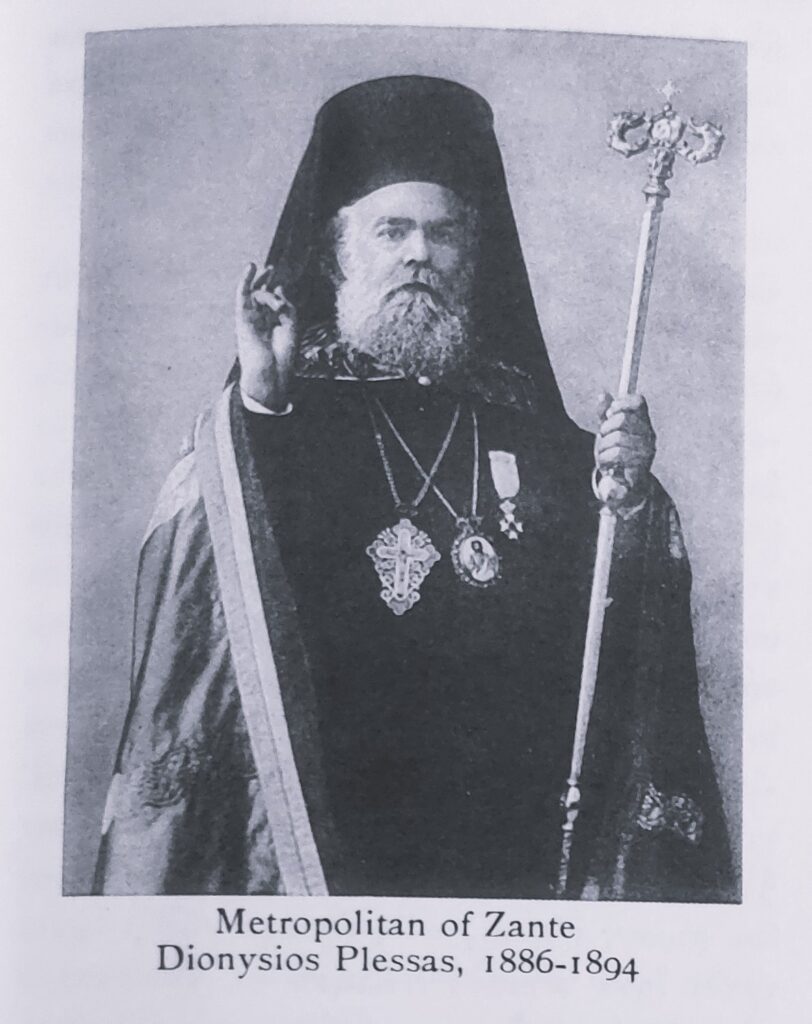
1895 – 1906: Antonios Paraschis, Metropolitan of Patras (1857 – 1944)
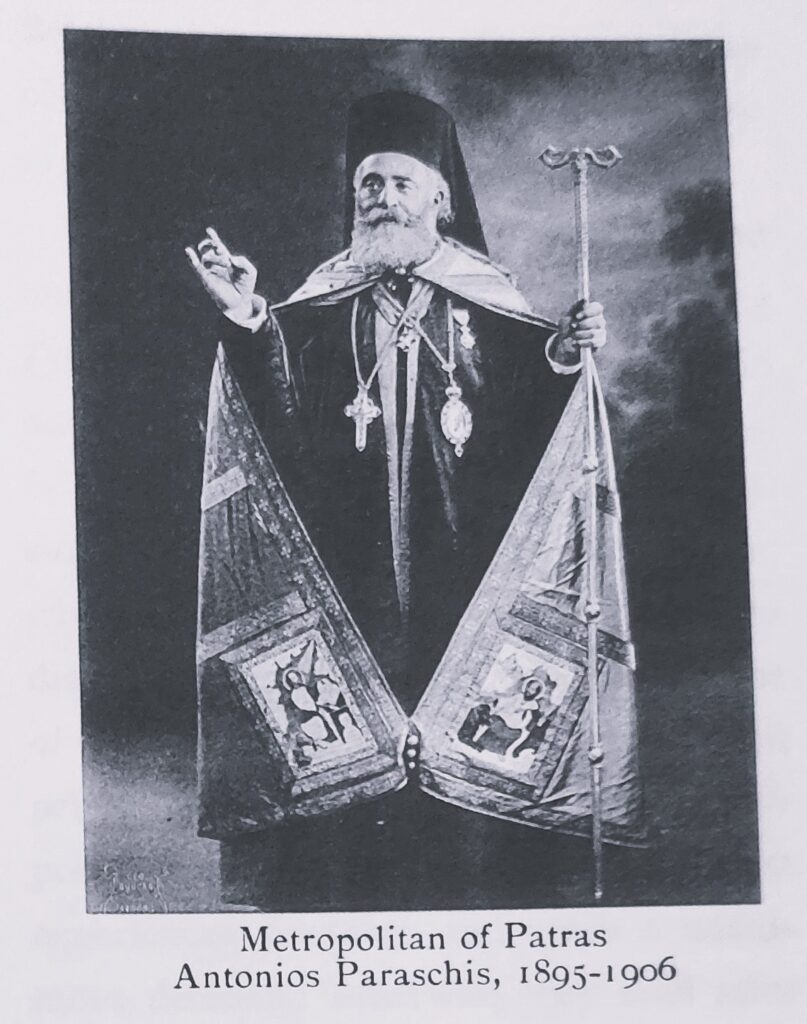
1907 – 1926: Constantine Pagonis. Formerly Great Archdeacon of the Patriarchate of Alexandria (1850s – 1932)
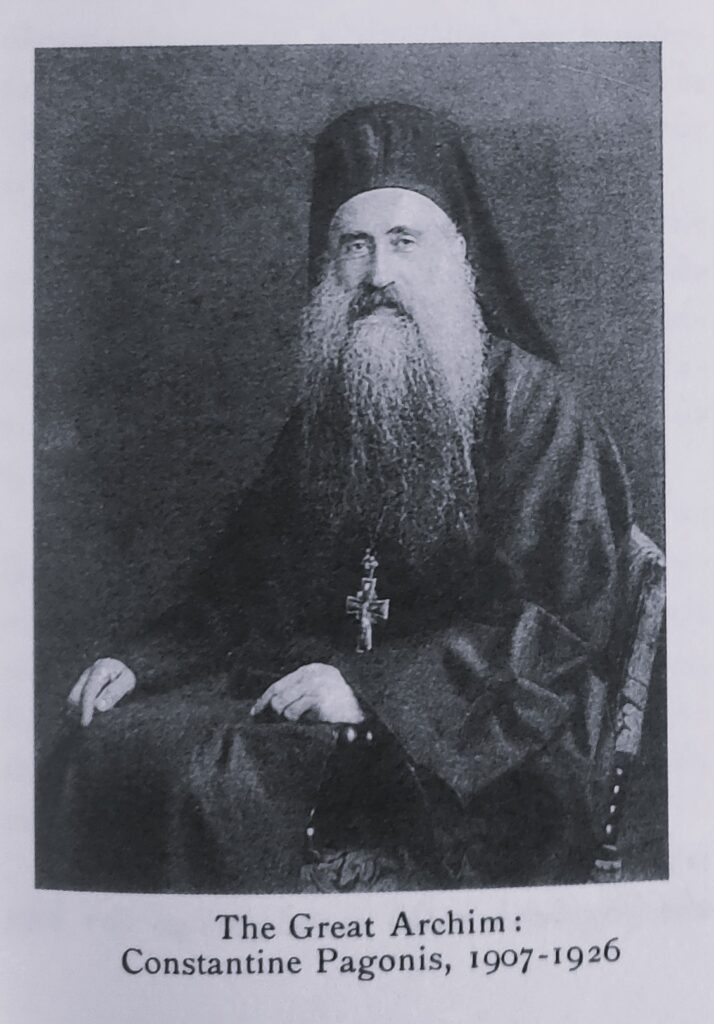
1927 – 1939: Michael Constandinidis. Archbishop of North and South America (1892-1958)
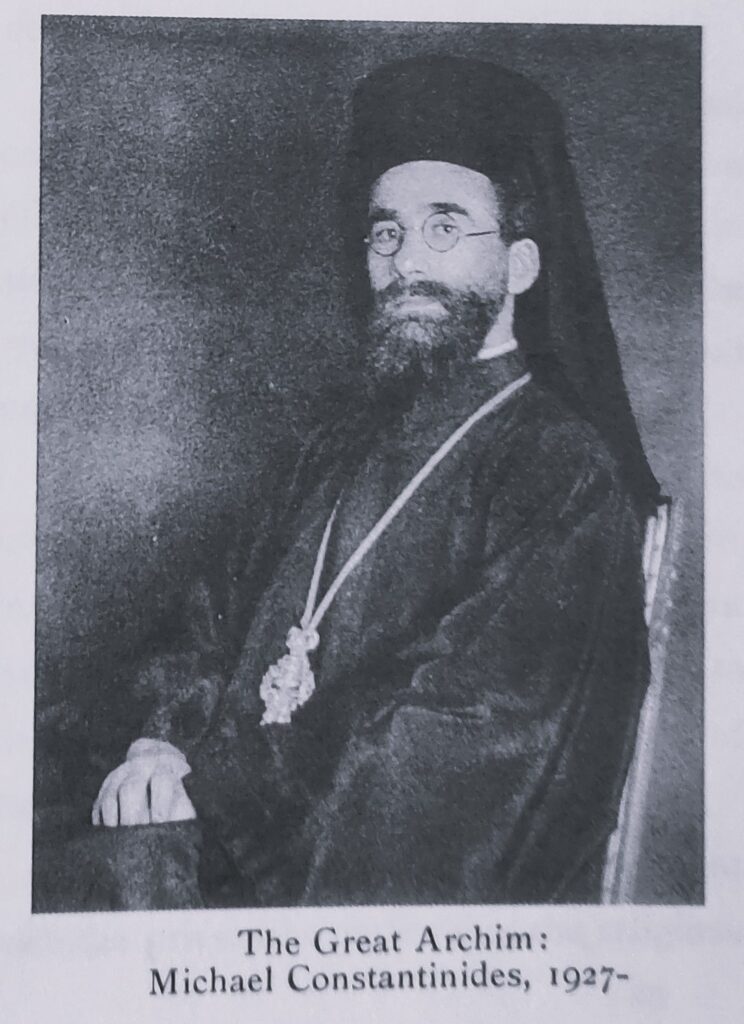
1939 – 1965: James Virvos, Metropolitan of Christoupolis. (1901- 1976)
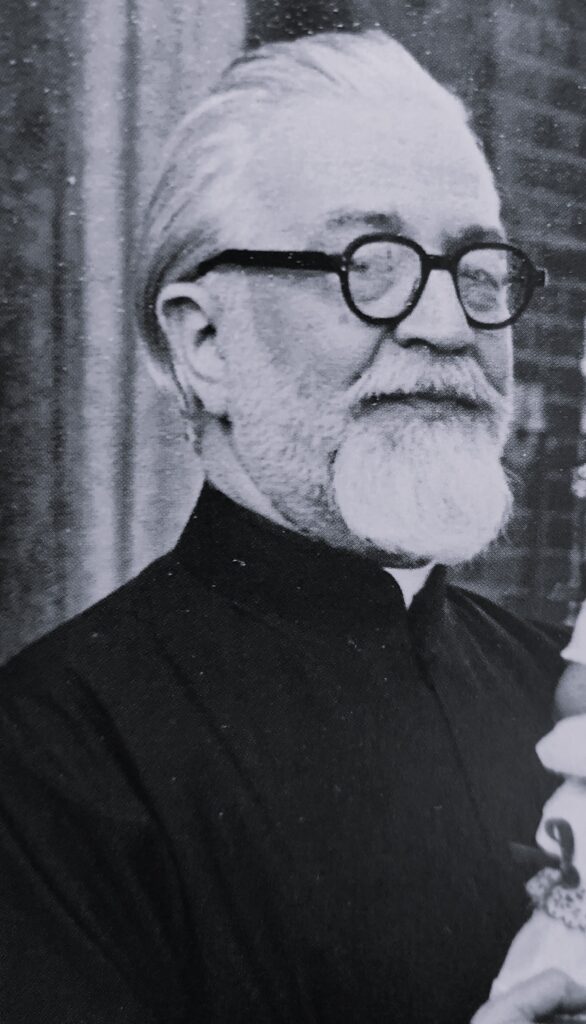
1965 – 1997: Timotheos Catsiyannis, Bishop of Militoupolis (1918 – 1998)
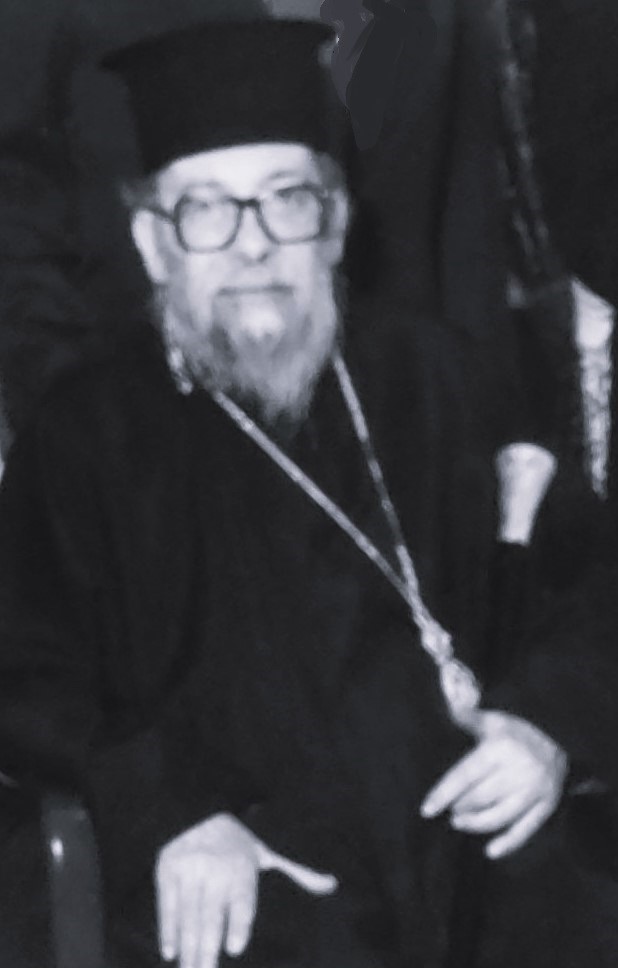
1997 – 2000: Archimadrites Panteleimon Coulouris (1969 – 2001) and George Karvounis (1977 -2002).
2000 – 2009: Theodoritos Polyzogopoulos, Bishop of Nazianzou, Metropolitan of Laodicia
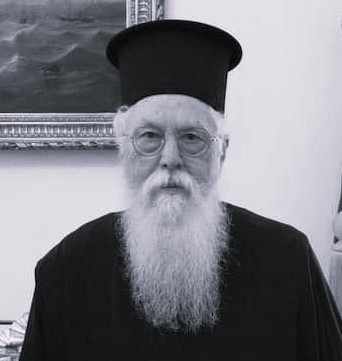
2009 – the present day: Theonas Bakalis. Archimandrite of the Ecumenical Throne
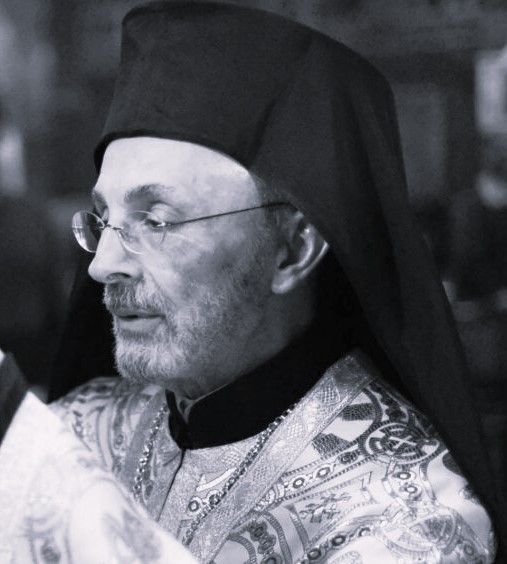
2024 – the present day. Nephon Tsimalis. Chancellor/Protosyncellus of the Archdiocese.
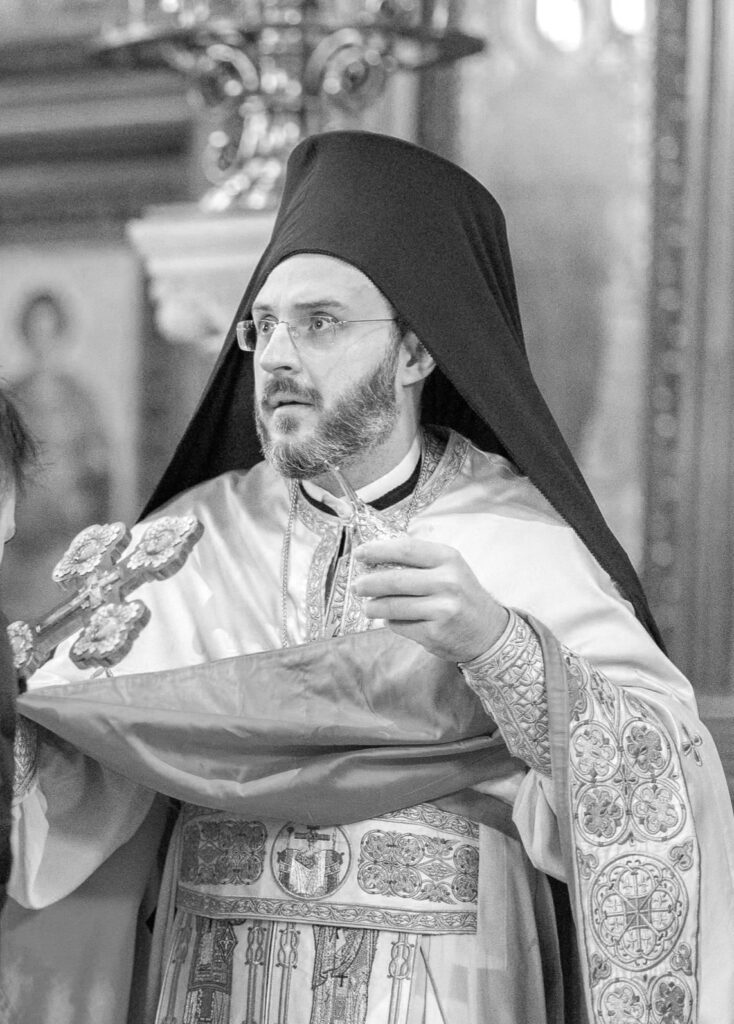
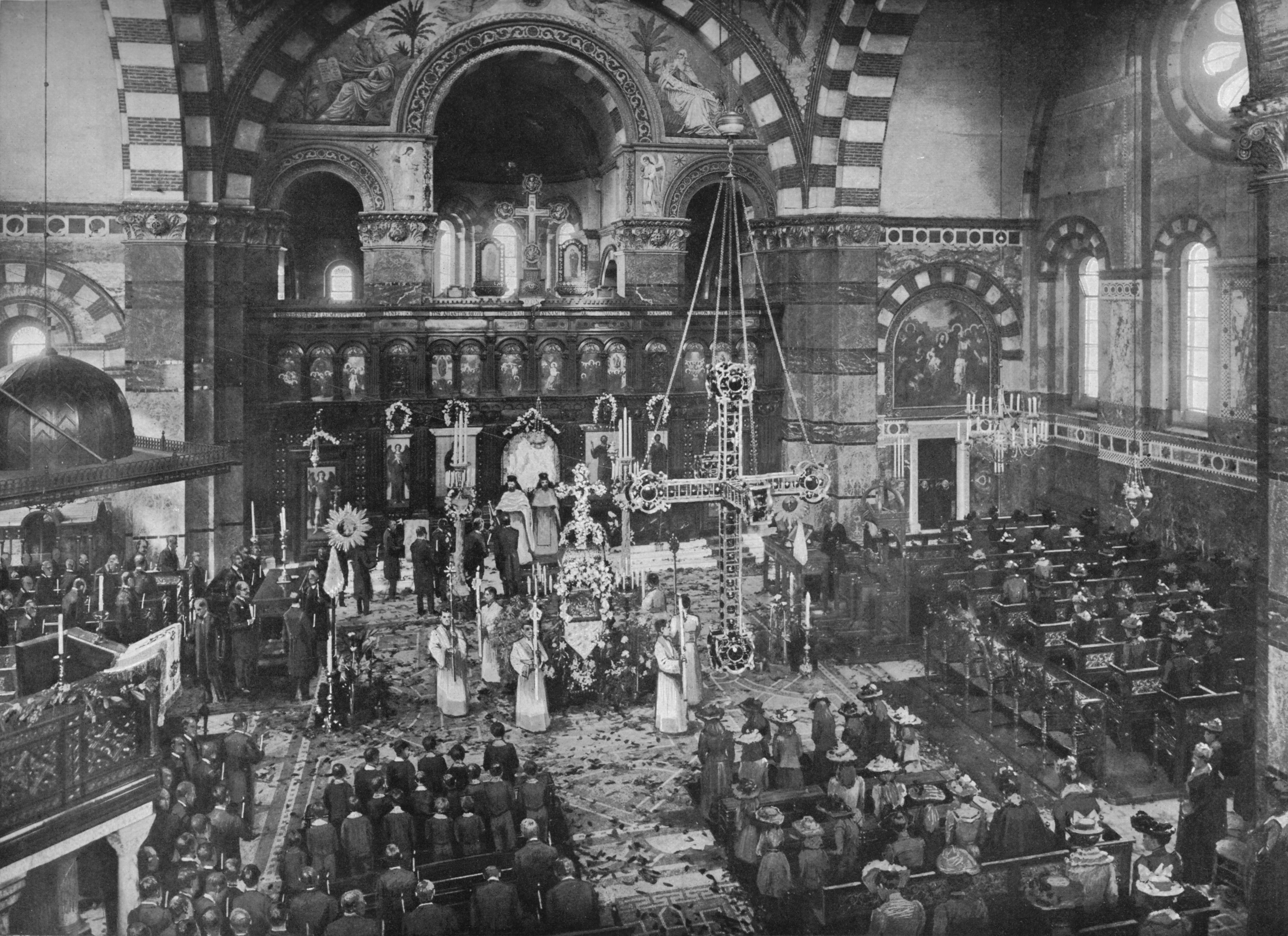
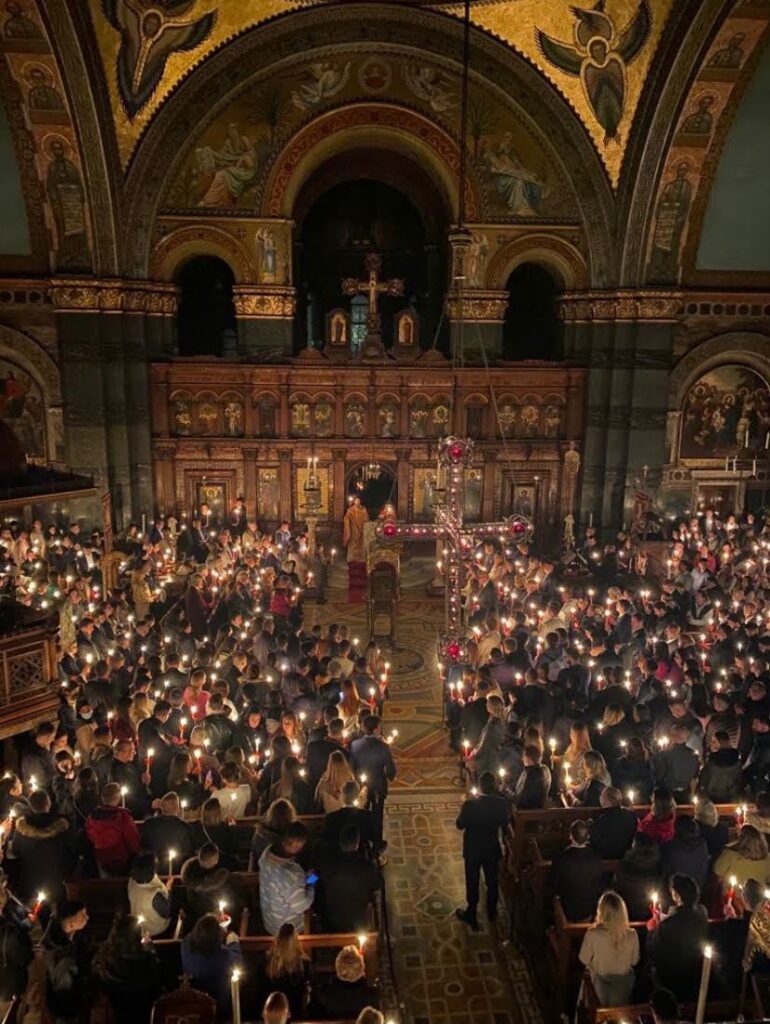
Sources: Constandinidis, Michael, The Greek Orthodox Church in London (1933)
Kakavas, George (Editor), Treasured Offerings: The Legacy of the Greek
Orthodox Cathedral of St. Sophia, London (2002)
Historic England. Cathedral of St Sophia List-entry1223553
Antonia Konzontis
Photos: Jessy Pappas Photography, Orthodox Herald, Getty/Hulton Archive. Ismini Gykas

